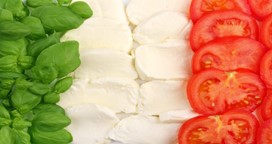
Your guide to Italian cheese
Whether you like it diced in a salad or melted on your pizza, Italian cheese is hugely popular across the western world, and is known for its diversity and decadence.
But what exactly is the difference between Parmesan and Pecorino, and is mozzarella di buffalo really made with buffalo’s milk? If cheese is your thing, then this guide to Italian cheese is for you.
Soft and Semi-soft Italian cheese
These Italian cheeses tend to be mild and creamy, although the blue cheeses pack a more powerful flavour punch!
Mozzarella
 Type: Fresh; semi-soft
Type: Fresh; semi-soft
Flavour: Mild, yet slightly sour
Perfect partner: Tomato and basil in a Caprese salad; or Beaujolais and Sauvignon Blanc wines
Mozzarella cheese is one of Italy’s most famous cheeses and is particularly versatile, giving a melted creaminess to pizza toppings but also is delicious eaten cold in an Italian salad.
It is a creamy curd cheese and is made according to a strict process – with “Mozzarella di Bufala Campana” being a DOC-protected brand. It belongs to the pasta filata family of cheeses and this type of cheese is made by heating the curd to the point where it can be stretched and shaped, giving mozzarella the classic ball shape.
Outside of Italy, you will typically find this cheese made from cow’s milk, but the traditional Italian way is to make it with water buffalo milk, which gives a rich cheese that is higher in calcium and protein, but lower in cholesterol than cheese made from cow’s milk.
Mascarpone
Type: Fresh; soft
Flavour: Mild and creamy
Perfect partner: Coffee and chocolate in a Tiramisu; or anchovies and spices in a savoury dish
Mascarpone cream cheese originates from the Lombardy region of Italy, which is home to Milan and the Italian Lake District. It has a high fat content of up to 75% and has a creamy and smooth texture, making it ideal for desserts, such as Tiramisu and Italian cheesecakes.
One of the wonderful things about mascarpone cheese is its mild flavour, which means that it can be added to dishes without overwhelming the flavour, making it particularly versatile – try adding it to creamy curries or pasta dishes, or serve it simply with berries for the perfect summer treat.
Ricotta di Pecora
 Type: Fresh; soft
Type: Fresh; soft
Flavour: Creamy and sweet
Perfect partner: Honey; or Vin Santo dessert wine
Ricotta di Pecora is a type of cottage cheese that is made in Italy from sheep’s milk in the region of Tuscany. It is a soft cheese with a creamy and crumbly texture, and so tends to be used in desserts and sweets – in fact, the Italians like to serve it drizzled with honey or sprinkled with sugar. If you would prefer to use it in a savoury dish, we recommend crumbling it over a salad for a creamy decadence.
Gorgonzola
Type: Blue
Flavour: Sharp (younger cheeses can be mild)
Perfect partner: Gnocchi; or Bordeaux, Zinfandel and Sauternes wines
Gorgonzola cheese is a blue-vein cheese made with cow’s milk and, thanks to the aging process that can take up to 4 months, it has a strong flavour that can make all the difference to a plain pasta or gnocchi dish. There are two general types: Gorgonzola Dolce (also called Sweet Gorgonzola) and Gorgonzola Piccante (also called Gorgonzola Naturale, Gorgonzola Montagna or Mountain Gorgonzola).
It is actually a protected cheese, meaning that it can only be made in a small number of Italian provinces near Milan, and is one of the world’s oldest blue-vein cheeses. Its flavour tends to be diverse as its sharpness depends on the length of the aging process so, if you’re a newbie to blue cheeses, you may prefer a younger Gorgonzola.
Hard Italian cheese
These hard Italian cheeses are perfect freshly grated over pasta for a hint of flavour without loading up on calories.
Parmesan (Parmigiano Reggiano)
 Type: Hard
Type: Hard
Flavour: Nutty
Perfect partner: Shaved over a fresh salad
Parmesan cheese is one of Italy’s most famous varieties and it has a nutty flavour that is perfect grated over fresh pasta or added to a crisp salad as thick shavings. It is made from cow’s milk and can be aged for up to 3 years as part of a DOP-protected process that can only be performed in Parma, Reggio Emilia, Bologna, Modena and southern Mantova.
The tradition of making Parmigiano Reggiano cheese dates back 800 years and, even today, it is still made according to a strict process that doesn’t use additives and even specifies that the cows from which the milk comes are fed a special diet with no silage.
Look for the Zanetti mark to be sure you’re buying the best!
Pecorino Romano
Type: Hard
Flavour: Sharp and salty
Perfect partner: Grated over pasta or warm bread; or team it with a light beer
Pecorino cheese is made from ewe’s milk (“pecora” is the Italian word for “sheep”), with many regions of Italy producing their own variety of this cheese; however, Pecorino Romano is PDO-protected, which means that it can only be made in Sardinia, Lazio and in the Tuscan province of Grosseto.
It is one of the most ancient types of Italian cheese, dating back to Roman times, with Varro, Pliny the Elder, Hippocrates and Columella all mentioning it in their writings. As with many of the Italian cheeses, it is made according to a special process that involves dry-salting the cheese and aging it for up to 12 months, giving it a strong flavour.
Note that the America version of Pecorino cheese is made from cow’s milk.
Grana Padano
Type: Hard
Flavour: Full
Perfect partner: Grapes and crackers as part of an Italian cheese board
“Grana” in Italian means “grainy” and the name of this iconic Italian cheese eludes to its crumbly texture, which is partly due to its lengthy aging process of at least 18 months.
The cheese, which is well known for the huge wheels that it comes in (usually around 70 pounds in weight), is made in North Italy around the Po Valley and can be purchased in three ripening stages that affect the flavour, with a fuller flavour and crumbly texture associated with the aged Grana Padano – try Grana Padano Riserva, which is ripened for over 20 months, for a grainy and crumbly cheese that packs a powerful full-flavoured punch!
Akin to Parmesan, look for the Zanetti mark for quality assurance.
We hope you enjoyed this guide to Italian cheese. If this travel blog has got you eager to try different Italian cheeses in their homeland, you may be interested in one of our Italy multi-centre holidays, such as our food tours of Italy. If you would like to find out more about our customised Italy holidays, please contact us.
Search Keywords
Enter keywords below to perform a search within the events to find more relevant posts